Marketing Strategy for Charlie's No Sugar Drink by The Better Drinks Company
VerifiedAdded on 2023/04/25
|9
|2447
|73
AI Summary
The report discusses the marketing strategy for Charlie's No Sugar Drink by The Better Drinks Company. It includes SWOT analysis, Porter's Five Forces analysis, market segmentation, targeting strategy, product USP, and 4P's marketing mix. The report also outlines the objectives of the product launch and the potential benefits for the health-conscious population.
Contribute Materials
Your contribution can guide someone’s learning journey. Share your
documents today.
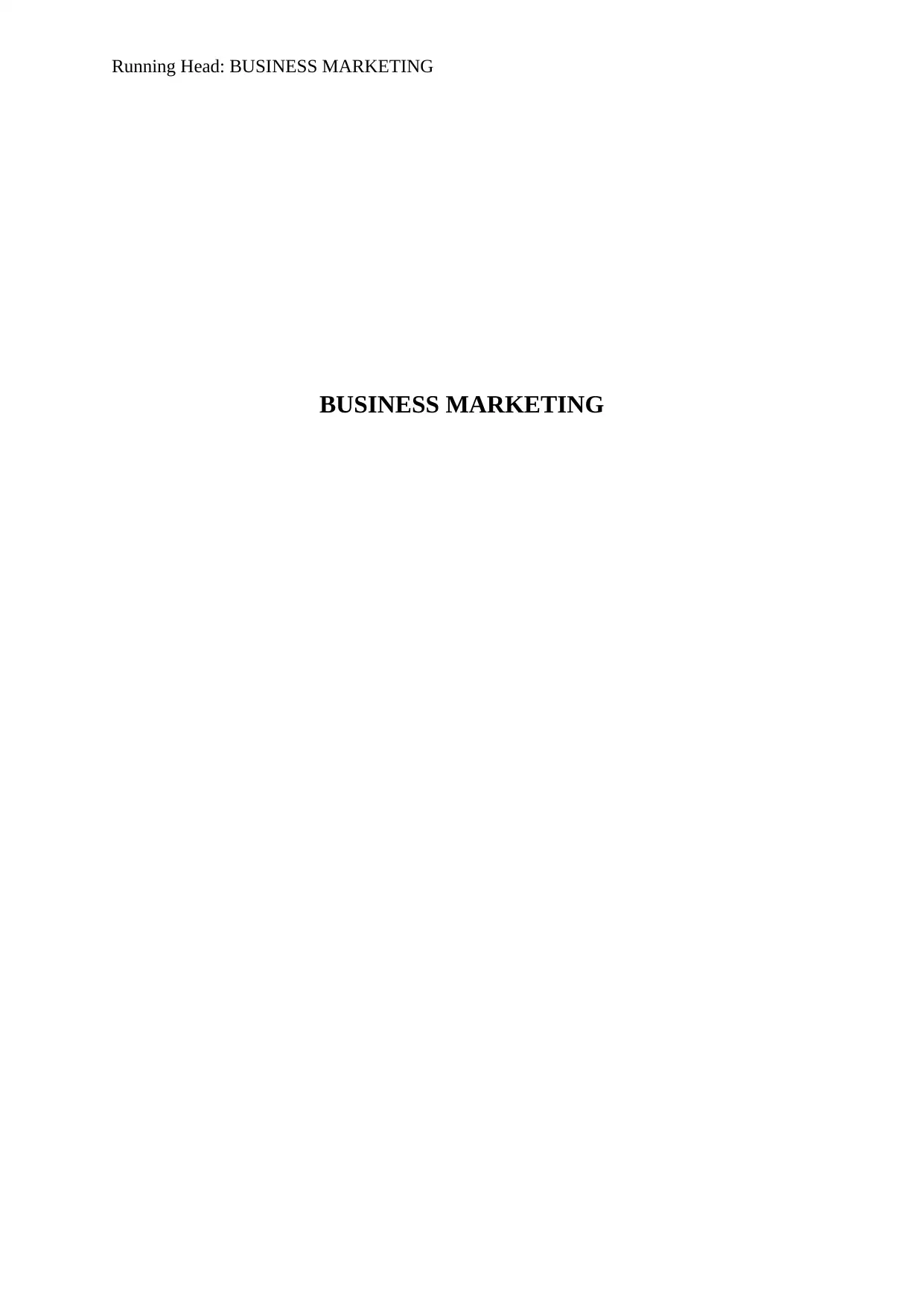
Running Head: BUSINESS MARKETING
BUSINESS MARKETING
BUSINESS MARKETING
Secure Best Marks with AI Grader
Need help grading? Try our AI Grader for instant feedback on your assignments.
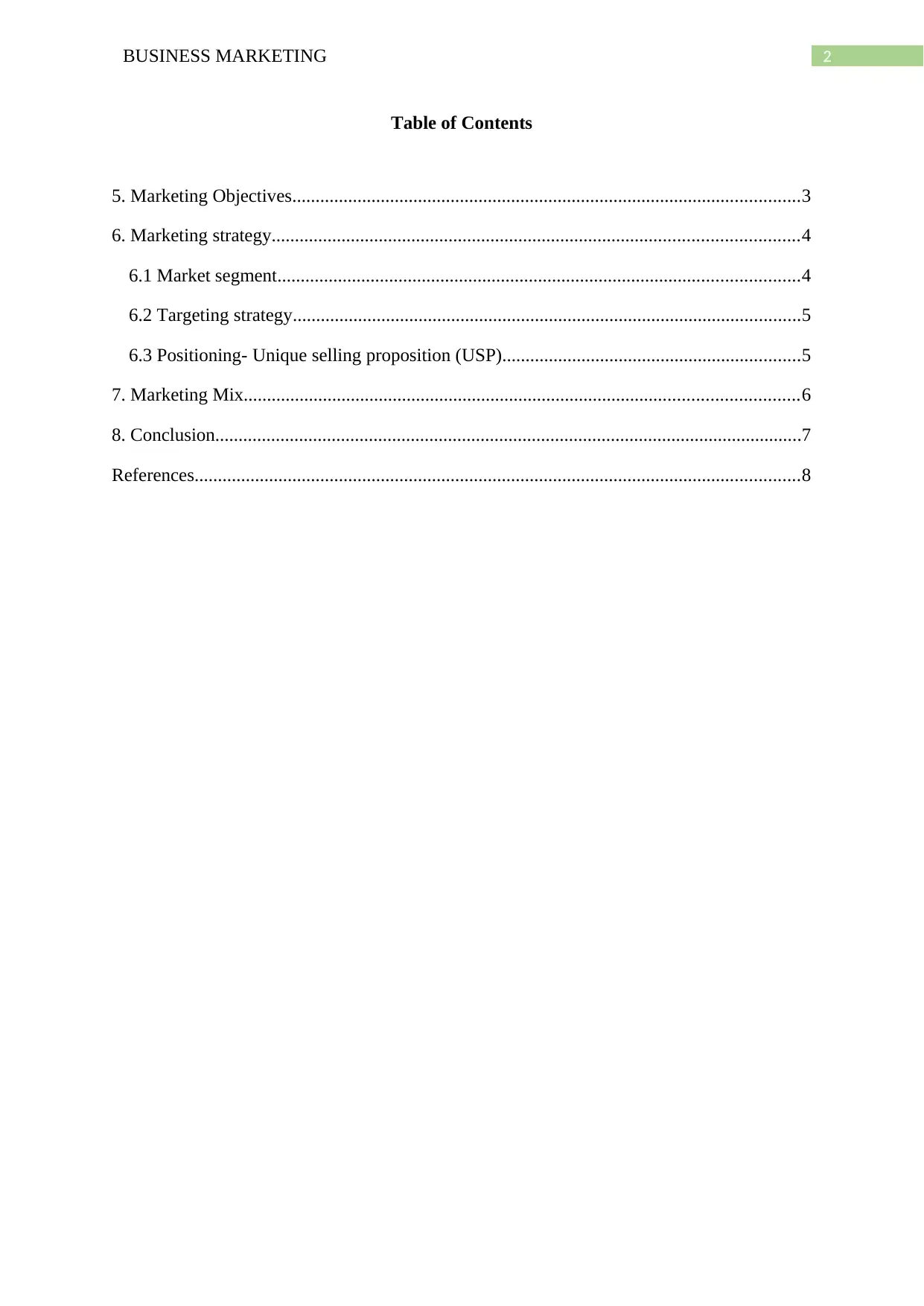
2BUSINESS MARKETING
Table of Contents
5. Marketing Objectives.............................................................................................................3
6. Marketing strategy.................................................................................................................4
6.1 Market segment................................................................................................................4
6.2 Targeting strategy.............................................................................................................5
6.3 Positioning- Unique selling proposition (USP)................................................................5
7. Marketing Mix.......................................................................................................................6
8. Conclusion..............................................................................................................................7
References..................................................................................................................................8
Table of Contents
5. Marketing Objectives.............................................................................................................3
6. Marketing strategy.................................................................................................................4
6.1 Market segment................................................................................................................4
6.2 Targeting strategy.............................................................................................................5
6.3 Positioning- Unique selling proposition (USP)................................................................5
7. Marketing Mix.......................................................................................................................6
8. Conclusion..............................................................................................................................7
References..................................................................................................................................8
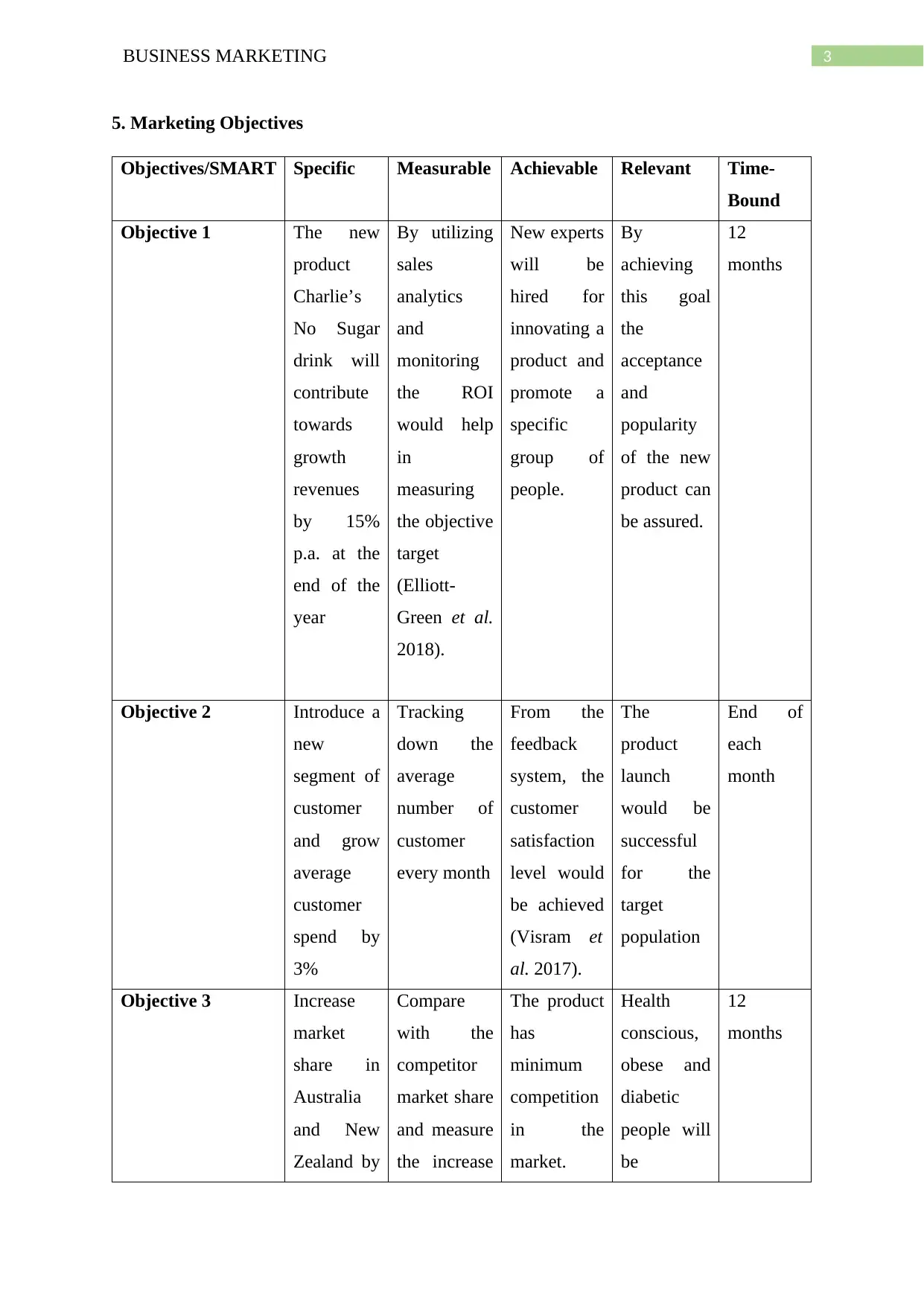
3BUSINESS MARKETING
5. Marketing Objectives
Objectives/SMART Specific Measurable Achievable Relevant Time-
Bound
Objective 1 The new
product
Charlie’s
No Sugar
drink will
contribute
towards
growth
revenues
by 15%
p.a. at the
end of the
year
By utilizing
sales
analytics
and
monitoring
the ROI
would help
in
measuring
the objective
target
(Elliott-
Green et al.
2018).
New experts
will be
hired for
innovating a
product and
promote a
specific
group of
people.
By
achieving
this goal
the
acceptance
and
popularity
of the new
product can
be assured.
12
months
Objective 2 Introduce a
new
segment of
customer
and grow
average
customer
spend by
3%
Tracking
down the
average
number of
customer
every month
From the
feedback
system, the
customer
satisfaction
level would
be achieved
(Visram et
al. 2017).
The
product
launch
would be
successful
for the
target
population
End of
each
month
Objective 3 Increase
market
share in
Australia
and New
Zealand by
Compare
with the
competitor
market share
and measure
the increase
The product
has
minimum
competition
in the
market.
Health
conscious,
obese and
diabetic
people will
be
12
months
5. Marketing Objectives
Objectives/SMART Specific Measurable Achievable Relevant Time-
Bound
Objective 1 The new
product
Charlie’s
No Sugar
drink will
contribute
towards
growth
revenues
by 15%
p.a. at the
end of the
year
By utilizing
sales
analytics
and
monitoring
the ROI
would help
in
measuring
the objective
target
(Elliott-
Green et al.
2018).
New experts
will be
hired for
innovating a
product and
promote a
specific
group of
people.
By
achieving
this goal
the
acceptance
and
popularity
of the new
product can
be assured.
12
months
Objective 2 Introduce a
new
segment of
customer
and grow
average
customer
spend by
3%
Tracking
down the
average
number of
customer
every month
From the
feedback
system, the
customer
satisfaction
level would
be achieved
(Visram et
al. 2017).
The
product
launch
would be
successful
for the
target
population
End of
each
month
Objective 3 Increase
market
share in
Australia
and New
Zealand by
Compare
with the
competitor
market share
and measure
the increase
The product
has
minimum
competition
in the
market.
Health
conscious,
obese and
diabetic
people will
be
12
months
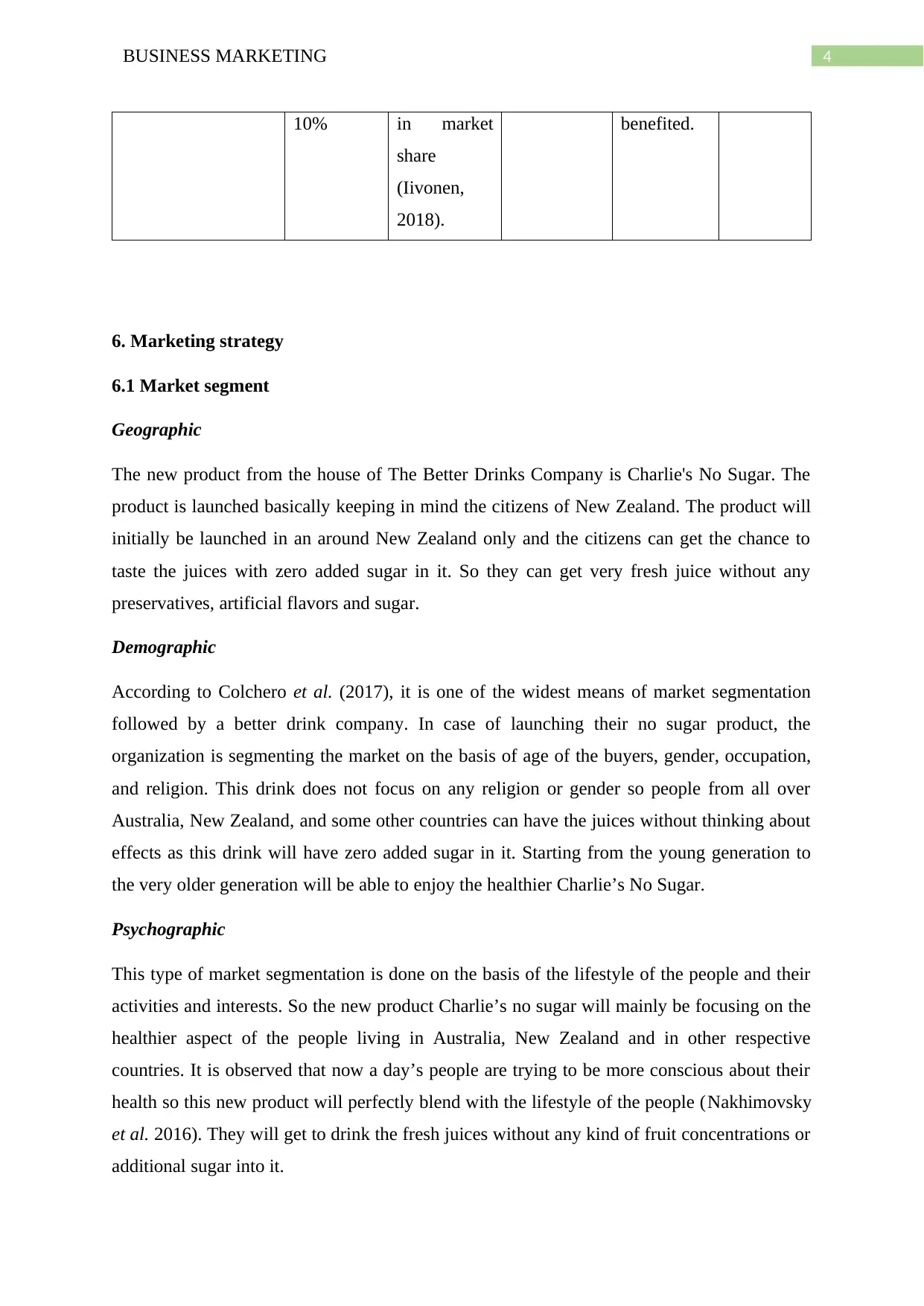
4BUSINESS MARKETING
10% in market
share
(Iivonen,
2018).
benefited.
6. Marketing strategy
6.1 Market segment
Geographic
The new product from the house of The Better Drinks Company is Charlie's No Sugar. The
product is launched basically keeping in mind the citizens of New Zealand. The product will
initially be launched in an around New Zealand only and the citizens can get the chance to
taste the juices with zero added sugar in it. So they can get very fresh juice without any
preservatives, artificial flavors and sugar.
Demographic
According to Colchero et al. (2017), it is one of the widest means of market segmentation
followed by a better drink company. In case of launching their no sugar product, the
organization is segmenting the market on the basis of age of the buyers, gender, occupation,
and religion. This drink does not focus on any religion or gender so people from all over
Australia, New Zealand, and some other countries can have the juices without thinking about
effects as this drink will have zero added sugar in it. Starting from the young generation to
the very older generation will be able to enjoy the healthier Charlie’s No Sugar.
Psychographic
This type of market segmentation is done on the basis of the lifestyle of the people and their
activities and interests. So the new product Charlie’s no sugar will mainly be focusing on the
healthier aspect of the people living in Australia, New Zealand and in other respective
countries. It is observed that now a day’s people are trying to be more conscious about their
health so this new product will perfectly blend with the lifestyle of the people (Nakhimovsky
et al. 2016). They will get to drink the fresh juices without any kind of fruit concentrations or
additional sugar into it.
10% in market
share
(Iivonen,
2018).
benefited.
6. Marketing strategy
6.1 Market segment
Geographic
The new product from the house of The Better Drinks Company is Charlie's No Sugar. The
product is launched basically keeping in mind the citizens of New Zealand. The product will
initially be launched in an around New Zealand only and the citizens can get the chance to
taste the juices with zero added sugar in it. So they can get very fresh juice without any
preservatives, artificial flavors and sugar.
Demographic
According to Colchero et al. (2017), it is one of the widest means of market segmentation
followed by a better drink company. In case of launching their no sugar product, the
organization is segmenting the market on the basis of age of the buyers, gender, occupation,
and religion. This drink does not focus on any religion or gender so people from all over
Australia, New Zealand, and some other countries can have the juices without thinking about
effects as this drink will have zero added sugar in it. Starting from the young generation to
the very older generation will be able to enjoy the healthier Charlie’s No Sugar.
Psychographic
This type of market segmentation is done on the basis of the lifestyle of the people and their
activities and interests. So the new product Charlie’s no sugar will mainly be focusing on the
healthier aspect of the people living in Australia, New Zealand and in other respective
countries. It is observed that now a day’s people are trying to be more conscious about their
health so this new product will perfectly blend with the lifestyle of the people (Nakhimovsky
et al. 2016). They will get to drink the fresh juices without any kind of fruit concentrations or
additional sugar into it.
Secure Best Marks with AI Grader
Need help grading? Try our AI Grader for instant feedback on your assignments.
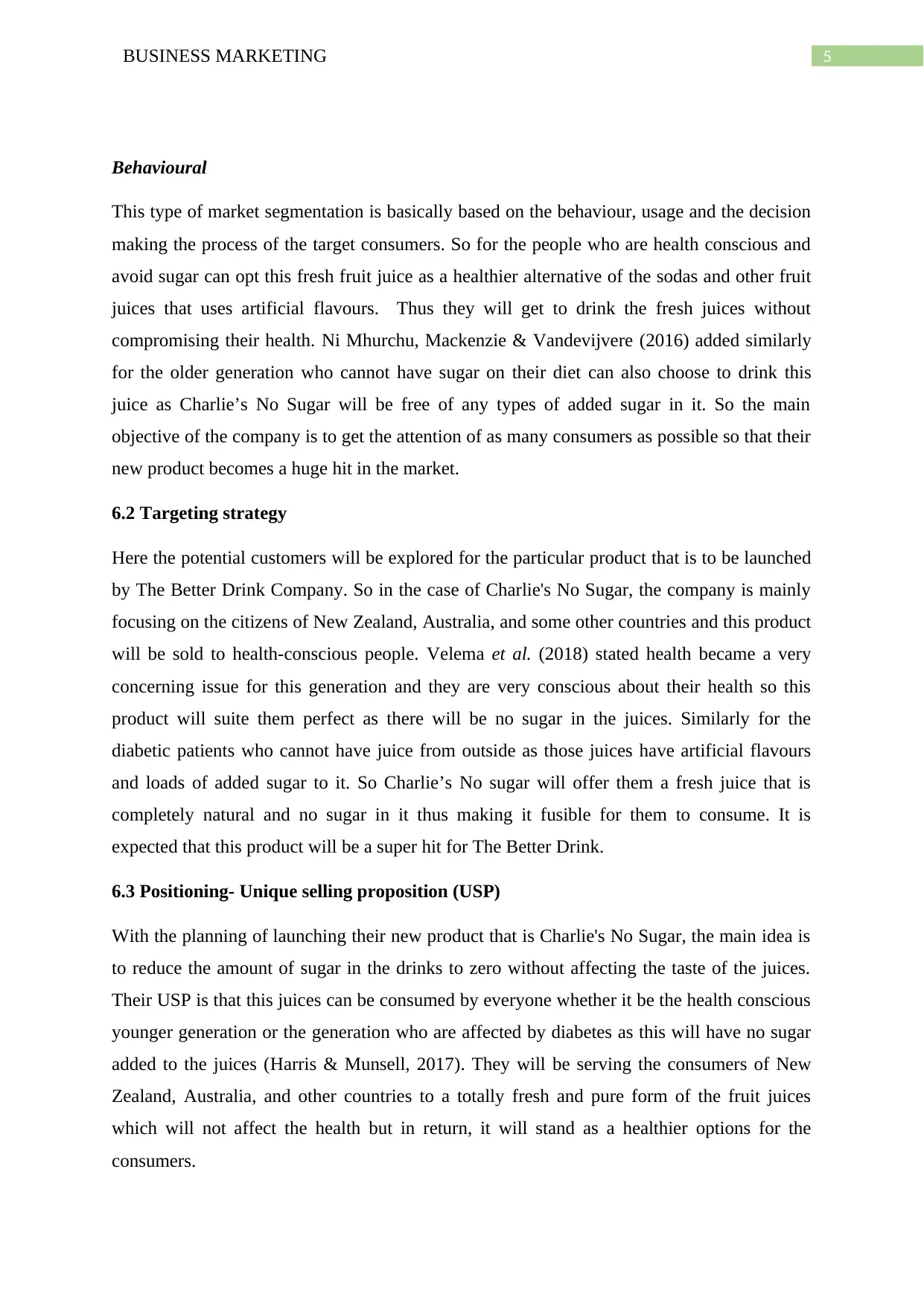
5BUSINESS MARKETING
Behavioural
This type of market segmentation is basically based on the behaviour, usage and the decision
making the process of the target consumers. So for the people who are health conscious and
avoid sugar can opt this fresh fruit juice as a healthier alternative of the sodas and other fruit
juices that uses artificial flavours. Thus they will get to drink the fresh juices without
compromising their health. Ni Mhurchu, Mackenzie & Vandevijvere (2016) added similarly
for the older generation who cannot have sugar on their diet can also choose to drink this
juice as Charlie’s No Sugar will be free of any types of added sugar in it. So the main
objective of the company is to get the attention of as many consumers as possible so that their
new product becomes a huge hit in the market.
6.2 Targeting strategy
Here the potential customers will be explored for the particular product that is to be launched
by The Better Drink Company. So in the case of Charlie's No Sugar, the company is mainly
focusing on the citizens of New Zealand, Australia, and some other countries and this product
will be sold to health-conscious people. Velema et al. (2018) stated health became a very
concerning issue for this generation and they are very conscious about their health so this
product will suite them perfect as there will be no sugar in the juices. Similarly for the
diabetic patients who cannot have juice from outside as those juices have artificial flavours
and loads of added sugar to it. So Charlie’s No sugar will offer them a fresh juice that is
completely natural and no sugar in it thus making it fusible for them to consume. It is
expected that this product will be a super hit for The Better Drink.
6.3 Positioning- Unique selling proposition (USP)
With the planning of launching their new product that is Charlie's No Sugar, the main idea is
to reduce the amount of sugar in the drinks to zero without affecting the taste of the juices.
Their USP is that this juices can be consumed by everyone whether it be the health conscious
younger generation or the generation who are affected by diabetes as this will have no sugar
added to the juices (Harris & Munsell, 2017). They will be serving the consumers of New
Zealand, Australia, and other countries to a totally fresh and pure form of the fruit juices
which will not affect the health but in return, it will stand as a healthier options for the
consumers.
Behavioural
This type of market segmentation is basically based on the behaviour, usage and the decision
making the process of the target consumers. So for the people who are health conscious and
avoid sugar can opt this fresh fruit juice as a healthier alternative of the sodas and other fruit
juices that uses artificial flavours. Thus they will get to drink the fresh juices without
compromising their health. Ni Mhurchu, Mackenzie & Vandevijvere (2016) added similarly
for the older generation who cannot have sugar on their diet can also choose to drink this
juice as Charlie’s No Sugar will be free of any types of added sugar in it. So the main
objective of the company is to get the attention of as many consumers as possible so that their
new product becomes a huge hit in the market.
6.2 Targeting strategy
Here the potential customers will be explored for the particular product that is to be launched
by The Better Drink Company. So in the case of Charlie's No Sugar, the company is mainly
focusing on the citizens of New Zealand, Australia, and some other countries and this product
will be sold to health-conscious people. Velema et al. (2018) stated health became a very
concerning issue for this generation and they are very conscious about their health so this
product will suite them perfect as there will be no sugar in the juices. Similarly for the
diabetic patients who cannot have juice from outside as those juices have artificial flavours
and loads of added sugar to it. So Charlie’s No sugar will offer them a fresh juice that is
completely natural and no sugar in it thus making it fusible for them to consume. It is
expected that this product will be a super hit for The Better Drink.
6.3 Positioning- Unique selling proposition (USP)
With the planning of launching their new product that is Charlie's No Sugar, the main idea is
to reduce the amount of sugar in the drinks to zero without affecting the taste of the juices.
Their USP is that this juices can be consumed by everyone whether it be the health conscious
younger generation or the generation who are affected by diabetes as this will have no sugar
added to the juices (Harris & Munsell, 2017). They will be serving the consumers of New
Zealand, Australia, and other countries to a totally fresh and pure form of the fruit juices
which will not affect the health but in return, it will stand as a healthier options for the
consumers.
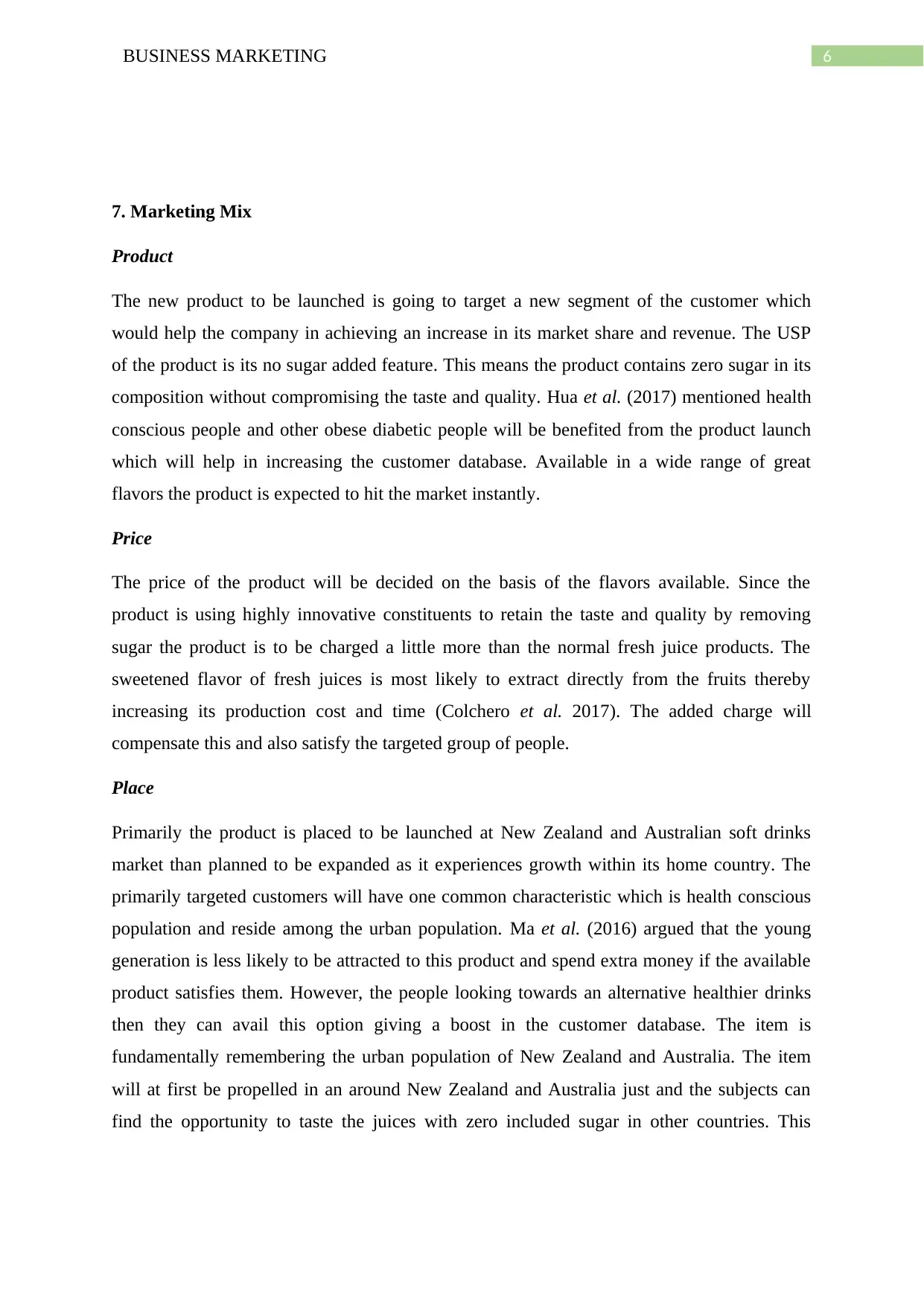
6BUSINESS MARKETING
7. Marketing Mix
Product
The new product to be launched is going to target a new segment of the customer which
would help the company in achieving an increase in its market share and revenue. The USP
of the product is its no sugar added feature. This means the product contains zero sugar in its
composition without compromising the taste and quality. Hua et al. (2017) mentioned health
conscious people and other obese diabetic people will be benefited from the product launch
which will help in increasing the customer database. Available in a wide range of great
flavors the product is expected to hit the market instantly.
Price
The price of the product will be decided on the basis of the flavors available. Since the
product is using highly innovative constituents to retain the taste and quality by removing
sugar the product is to be charged a little more than the normal fresh juice products. The
sweetened flavor of fresh juices is most likely to extract directly from the fruits thereby
increasing its production cost and time (Colchero et al. 2017). The added charge will
compensate this and also satisfy the targeted group of people.
Place
Primarily the product is placed to be launched at New Zealand and Australian soft drinks
market than planned to be expanded as it experiences growth within its home country. The
primarily targeted customers will have one common characteristic which is health conscious
population and reside among the urban population. Ma et al. (2016) argued that the young
generation is less likely to be attracted to this product and spend extra money if the available
product satisfies them. However, the people looking towards an alternative healthier drinks
then they can avail this option giving a boost in the customer database. The item is
fundamentally remembering the urban population of New Zealand and Australia. The item
will at first be propelled in an around New Zealand and Australia just and the subjects can
find the opportunity to taste the juices with zero included sugar in other countries. This
7. Marketing Mix
Product
The new product to be launched is going to target a new segment of the customer which
would help the company in achieving an increase in its market share and revenue. The USP
of the product is its no sugar added feature. This means the product contains zero sugar in its
composition without compromising the taste and quality. Hua et al. (2017) mentioned health
conscious people and other obese diabetic people will be benefited from the product launch
which will help in increasing the customer database. Available in a wide range of great
flavors the product is expected to hit the market instantly.
Price
The price of the product will be decided on the basis of the flavors available. Since the
product is using highly innovative constituents to retain the taste and quality by removing
sugar the product is to be charged a little more than the normal fresh juice products. The
sweetened flavor of fresh juices is most likely to extract directly from the fruits thereby
increasing its production cost and time (Colchero et al. 2017). The added charge will
compensate this and also satisfy the targeted group of people.
Place
Primarily the product is placed to be launched at New Zealand and Australian soft drinks
market than planned to be expanded as it experiences growth within its home country. The
primarily targeted customers will have one common characteristic which is health conscious
population and reside among the urban population. Ma et al. (2016) argued that the young
generation is less likely to be attracted to this product and spend extra money if the available
product satisfies them. However, the people looking towards an alternative healthier drinks
then they can avail this option giving a boost in the customer database. The item is
fundamentally remembering the urban population of New Zealand and Australia. The item
will at first be propelled in an around New Zealand and Australia just and the subjects can
find the opportunity to taste the juices with zero included sugar in other countries. This
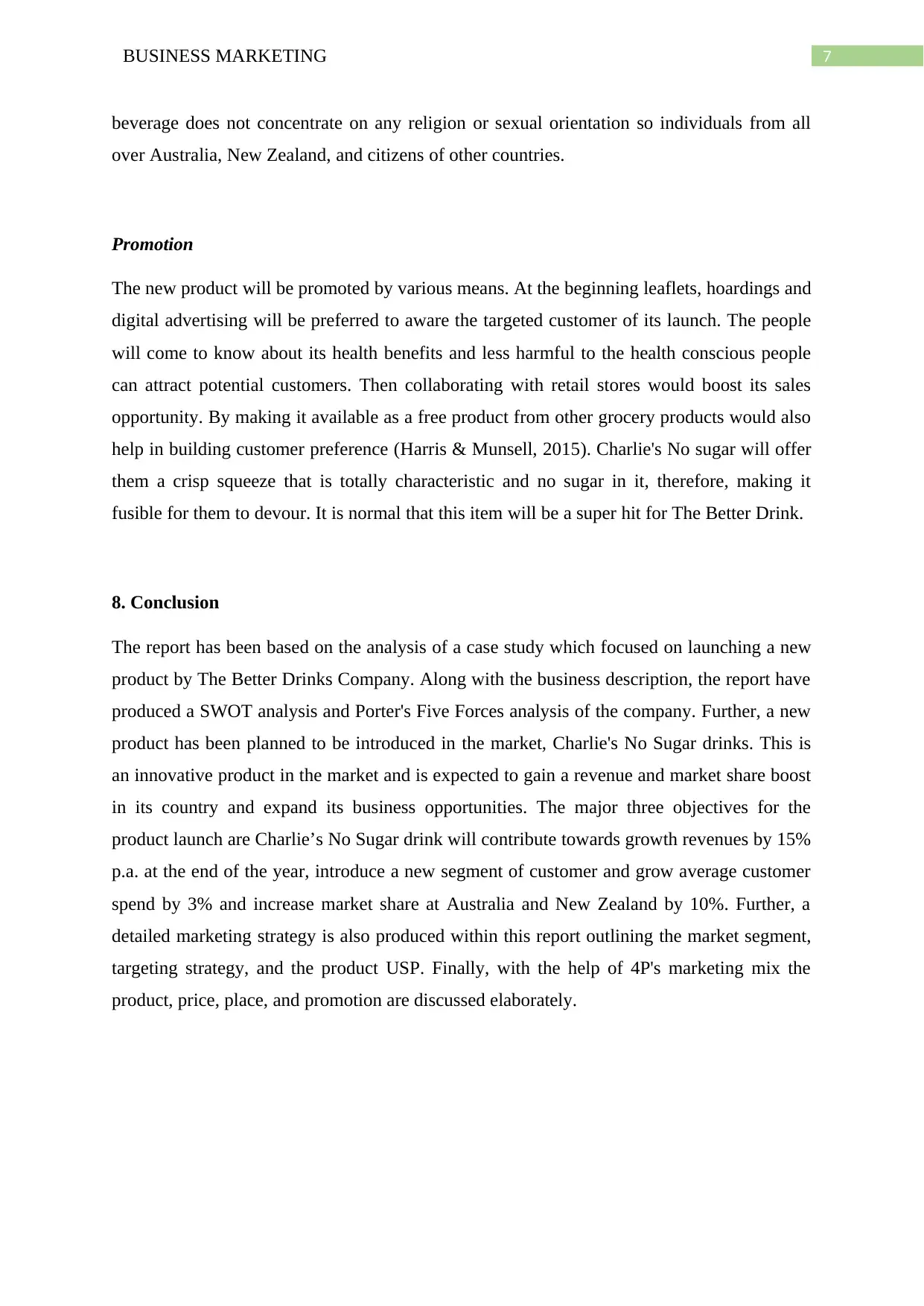
7BUSINESS MARKETING
beverage does not concentrate on any religion or sexual orientation so individuals from all
over Australia, New Zealand, and citizens of other countries.
Promotion
The new product will be promoted by various means. At the beginning leaflets, hoardings and
digital advertising will be preferred to aware the targeted customer of its launch. The people
will come to know about its health benefits and less harmful to the health conscious people
can attract potential customers. Then collaborating with retail stores would boost its sales
opportunity. By making it available as a free product from other grocery products would also
help in building customer preference (Harris & Munsell, 2015). Charlie's No sugar will offer
them a crisp squeeze that is totally characteristic and no sugar in it, therefore, making it
fusible for them to devour. It is normal that this item will be a super hit for The Better Drink.
8. Conclusion
The report has been based on the analysis of a case study which focused on launching a new
product by The Better Drinks Company. Along with the business description, the report have
produced a SWOT analysis and Porter's Five Forces analysis of the company. Further, a new
product has been planned to be introduced in the market, Charlie's No Sugar drinks. This is
an innovative product in the market and is expected to gain a revenue and market share boost
in its country and expand its business opportunities. The major three objectives for the
product launch are Charlie’s No Sugar drink will contribute towards growth revenues by 15%
p.a. at the end of the year, introduce a new segment of customer and grow average customer
spend by 3% and increase market share at Australia and New Zealand by 10%. Further, a
detailed marketing strategy is also produced within this report outlining the market segment,
targeting strategy, and the product USP. Finally, with the help of 4P's marketing mix the
product, price, place, and promotion are discussed elaborately.
beverage does not concentrate on any religion or sexual orientation so individuals from all
over Australia, New Zealand, and citizens of other countries.
Promotion
The new product will be promoted by various means. At the beginning leaflets, hoardings and
digital advertising will be preferred to aware the targeted customer of its launch. The people
will come to know about its health benefits and less harmful to the health conscious people
can attract potential customers. Then collaborating with retail stores would boost its sales
opportunity. By making it available as a free product from other grocery products would also
help in building customer preference (Harris & Munsell, 2015). Charlie's No sugar will offer
them a crisp squeeze that is totally characteristic and no sugar in it, therefore, making it
fusible for them to devour. It is normal that this item will be a super hit for The Better Drink.
8. Conclusion
The report has been based on the analysis of a case study which focused on launching a new
product by The Better Drinks Company. Along with the business description, the report have
produced a SWOT analysis and Porter's Five Forces analysis of the company. Further, a new
product has been planned to be introduced in the market, Charlie's No Sugar drinks. This is
an innovative product in the market and is expected to gain a revenue and market share boost
in its country and expand its business opportunities. The major three objectives for the
product launch are Charlie’s No Sugar drink will contribute towards growth revenues by 15%
p.a. at the end of the year, introduce a new segment of customer and grow average customer
spend by 3% and increase market share at Australia and New Zealand by 10%. Further, a
detailed marketing strategy is also produced within this report outlining the market segment,
targeting strategy, and the product USP. Finally, with the help of 4P's marketing mix the
product, price, place, and promotion are discussed elaborately.
Paraphrase This Document
Need a fresh take? Get an instant paraphrase of this document with our AI Paraphraser
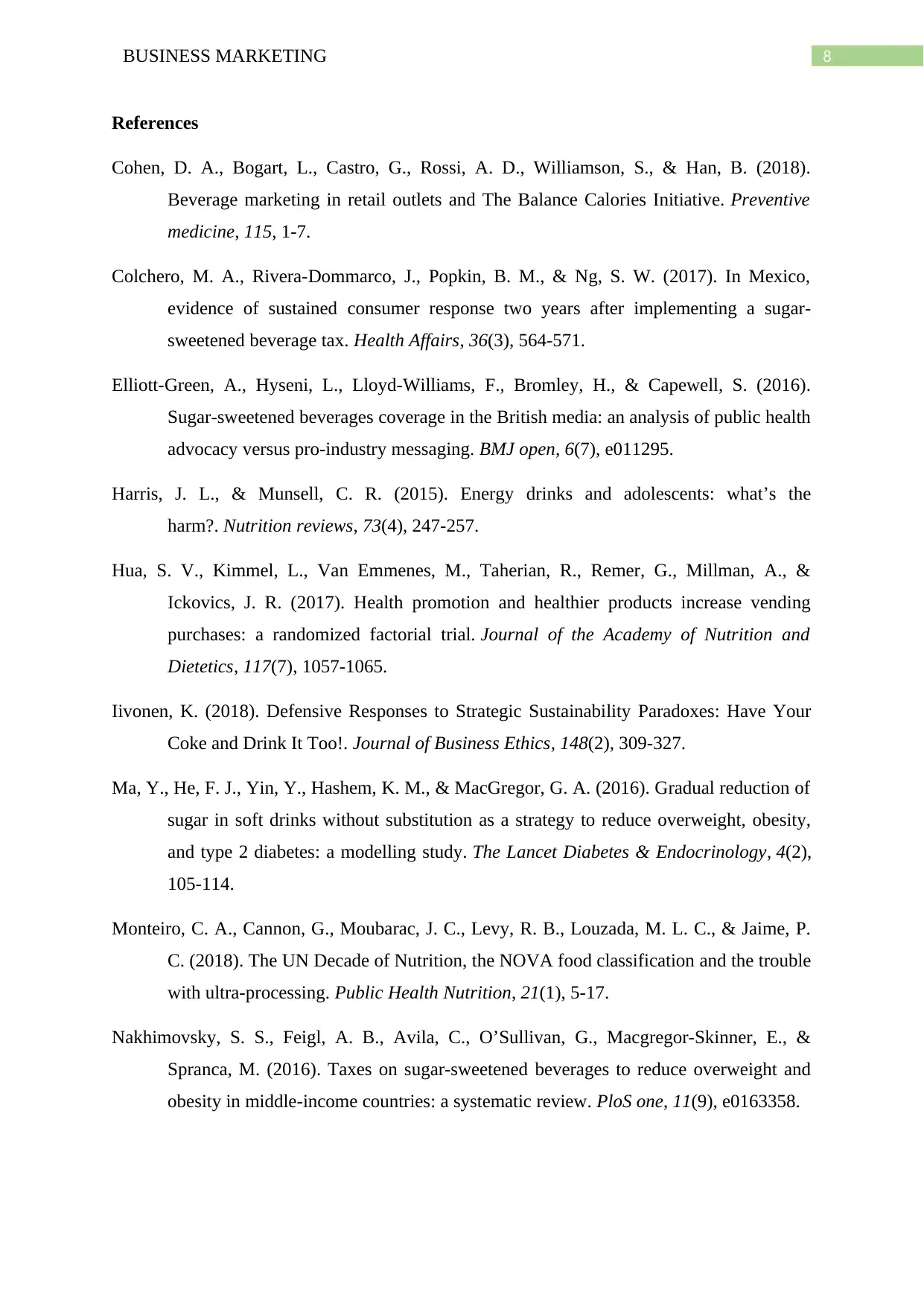
8BUSINESS MARKETING
References
Cohen, D. A., Bogart, L., Castro, G., Rossi, A. D., Williamson, S., & Han, B. (2018).
Beverage marketing in retail outlets and The Balance Calories Initiative. Preventive
medicine, 115, 1-7.
Colchero, M. A., Rivera-Dommarco, J., Popkin, B. M., & Ng, S. W. (2017). In Mexico,
evidence of sustained consumer response two years after implementing a sugar-
sweetened beverage tax. Health Affairs, 36(3), 564-571.
Elliott-Green, A., Hyseni, L., Lloyd-Williams, F., Bromley, H., & Capewell, S. (2016).
Sugar-sweetened beverages coverage in the British media: an analysis of public health
advocacy versus pro-industry messaging. BMJ open, 6(7), e011295.
Harris, J. L., & Munsell, C. R. (2015). Energy drinks and adolescents: what’s the
harm?. Nutrition reviews, 73(4), 247-257.
Hua, S. V., Kimmel, L., Van Emmenes, M., Taherian, R., Remer, G., Millman, A., &
Ickovics, J. R. (2017). Health promotion and healthier products increase vending
purchases: a randomized factorial trial. Journal of the Academy of Nutrition and
Dietetics, 117(7), 1057-1065.
Iivonen, K. (2018). Defensive Responses to Strategic Sustainability Paradoxes: Have Your
Coke and Drink It Too!. Journal of Business Ethics, 148(2), 309-327.
Ma, Y., He, F. J., Yin, Y., Hashem, K. M., & MacGregor, G. A. (2016). Gradual reduction of
sugar in soft drinks without substitution as a strategy to reduce overweight, obesity,
and type 2 diabetes: a modelling study. The Lancet Diabetes & Endocrinology, 4(2),
105-114.
Monteiro, C. A., Cannon, G., Moubarac, J. C., Levy, R. B., Louzada, M. L. C., & Jaime, P.
C. (2018). The UN Decade of Nutrition, the NOVA food classification and the trouble
with ultra-processing. Public Health Nutrition, 21(1), 5-17.
Nakhimovsky, S. S., Feigl, A. B., Avila, C., O’Sullivan, G., Macgregor-Skinner, E., &
Spranca, M. (2016). Taxes on sugar-sweetened beverages to reduce overweight and
obesity in middle-income countries: a systematic review. PloS one, 11(9), e0163358.
References
Cohen, D. A., Bogart, L., Castro, G., Rossi, A. D., Williamson, S., & Han, B. (2018).
Beverage marketing in retail outlets and The Balance Calories Initiative. Preventive
medicine, 115, 1-7.
Colchero, M. A., Rivera-Dommarco, J., Popkin, B. M., & Ng, S. W. (2017). In Mexico,
evidence of sustained consumer response two years after implementing a sugar-
sweetened beverage tax. Health Affairs, 36(3), 564-571.
Elliott-Green, A., Hyseni, L., Lloyd-Williams, F., Bromley, H., & Capewell, S. (2016).
Sugar-sweetened beverages coverage in the British media: an analysis of public health
advocacy versus pro-industry messaging. BMJ open, 6(7), e011295.
Harris, J. L., & Munsell, C. R. (2015). Energy drinks and adolescents: what’s the
harm?. Nutrition reviews, 73(4), 247-257.
Hua, S. V., Kimmel, L., Van Emmenes, M., Taherian, R., Remer, G., Millman, A., &
Ickovics, J. R. (2017). Health promotion and healthier products increase vending
purchases: a randomized factorial trial. Journal of the Academy of Nutrition and
Dietetics, 117(7), 1057-1065.
Iivonen, K. (2018). Defensive Responses to Strategic Sustainability Paradoxes: Have Your
Coke and Drink It Too!. Journal of Business Ethics, 148(2), 309-327.
Ma, Y., He, F. J., Yin, Y., Hashem, K. M., & MacGregor, G. A. (2016). Gradual reduction of
sugar in soft drinks without substitution as a strategy to reduce overweight, obesity,
and type 2 diabetes: a modelling study. The Lancet Diabetes & Endocrinology, 4(2),
105-114.
Monteiro, C. A., Cannon, G., Moubarac, J. C., Levy, R. B., Louzada, M. L. C., & Jaime, P.
C. (2018). The UN Decade of Nutrition, the NOVA food classification and the trouble
with ultra-processing. Public Health Nutrition, 21(1), 5-17.
Nakhimovsky, S. S., Feigl, A. B., Avila, C., O’Sullivan, G., Macgregor-Skinner, E., &
Spranca, M. (2016). Taxes on sugar-sweetened beverages to reduce overweight and
obesity in middle-income countries: a systematic review. PloS one, 11(9), e0163358.
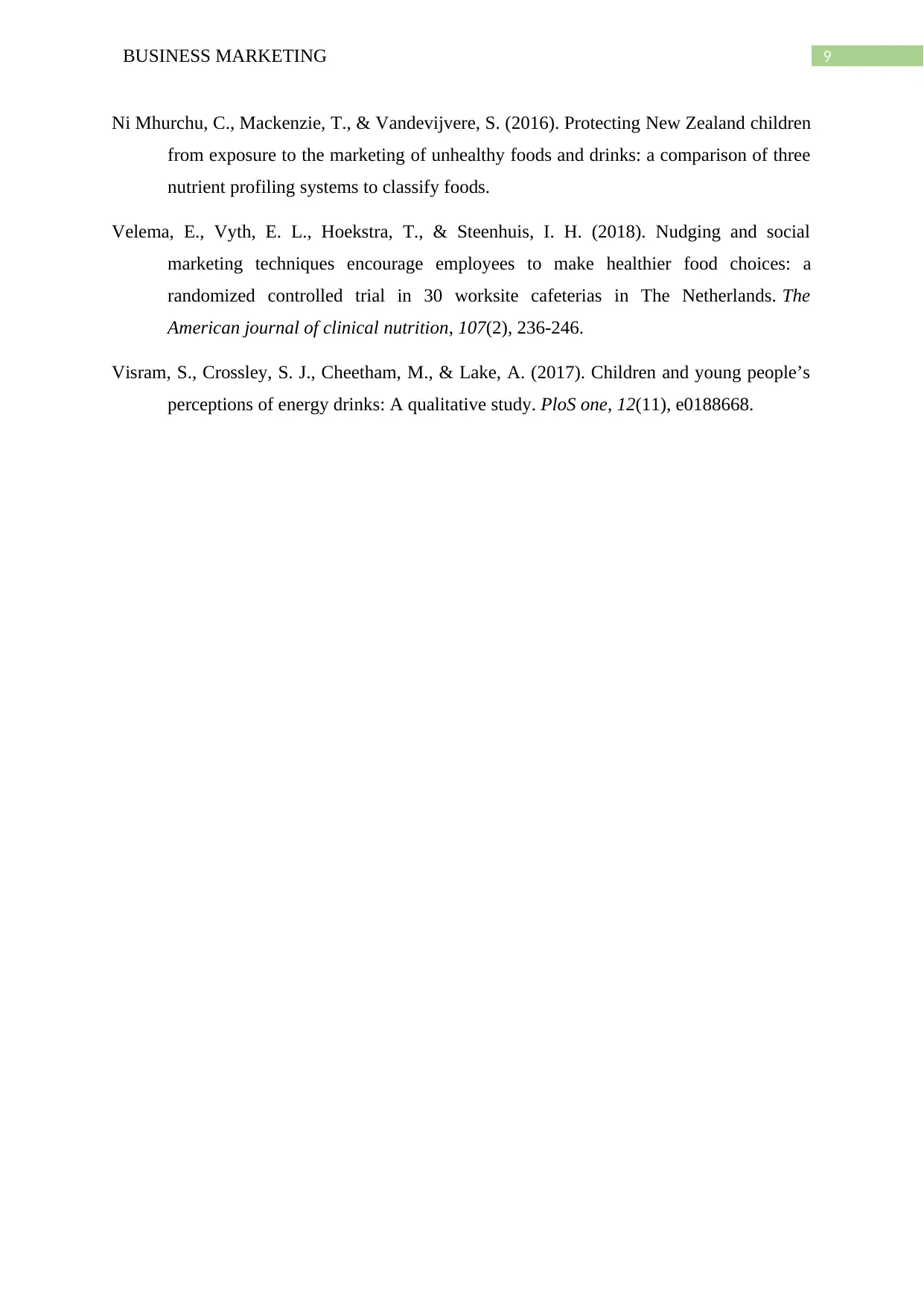
9BUSINESS MARKETING
Ni Mhurchu, C., Mackenzie, T., & Vandevijvere, S. (2016). Protecting New Zealand children
from exposure to the marketing of unhealthy foods and drinks: a comparison of three
nutrient profiling systems to classify foods.
Velema, E., Vyth, E. L., Hoekstra, T., & Steenhuis, I. H. (2018). Nudging and social
marketing techniques encourage employees to make healthier food choices: a
randomized controlled trial in 30 worksite cafeterias in The Netherlands. The
American journal of clinical nutrition, 107(2), 236-246.
Visram, S., Crossley, S. J., Cheetham, M., & Lake, A. (2017). Children and young people’s
perceptions of energy drinks: A qualitative study. PloS one, 12(11), e0188668.
Ni Mhurchu, C., Mackenzie, T., & Vandevijvere, S. (2016). Protecting New Zealand children
from exposure to the marketing of unhealthy foods and drinks: a comparison of three
nutrient profiling systems to classify foods.
Velema, E., Vyth, E. L., Hoekstra, T., & Steenhuis, I. H. (2018). Nudging and social
marketing techniques encourage employees to make healthier food choices: a
randomized controlled trial in 30 worksite cafeterias in The Netherlands. The
American journal of clinical nutrition, 107(2), 236-246.
Visram, S., Crossley, S. J., Cheetham, M., & Lake, A. (2017). Children and young people’s
perceptions of energy drinks: A qualitative study. PloS one, 12(11), e0188668.
1 out of 9
Related Documents
Your All-in-One AI-Powered Toolkit for Academic Success.
+13062052269
info@desklib.com
Available 24*7 on WhatsApp / Email
![[object Object]](/_next/static/media/star-bottom.7253800d.svg)
Unlock your academic potential
© 2024 | Zucol Services PVT LTD | All rights reserved.





